Catedral (interior)
last update: 31 January 2021
Introduction
I have occasionally mentioned the writings of a traveller from 1838, and with respect to the Cathedral he praised its noble proportions.
However he felt that it was "heavy, over-ornamented, and disfigured in an extraordinary degree with gilt chapels, carved saints, and votive offerings".
We will see, this webpage is specifically devoted to the different chapels, and the detail of decoration in the Cathedral. However, we will stay focussed on the most important things to see.
Our starting point is the same plan as found on my introductory webpage to the Cathedral. This plan came from the website of the Cathedral (there are alternative versions on the Web).
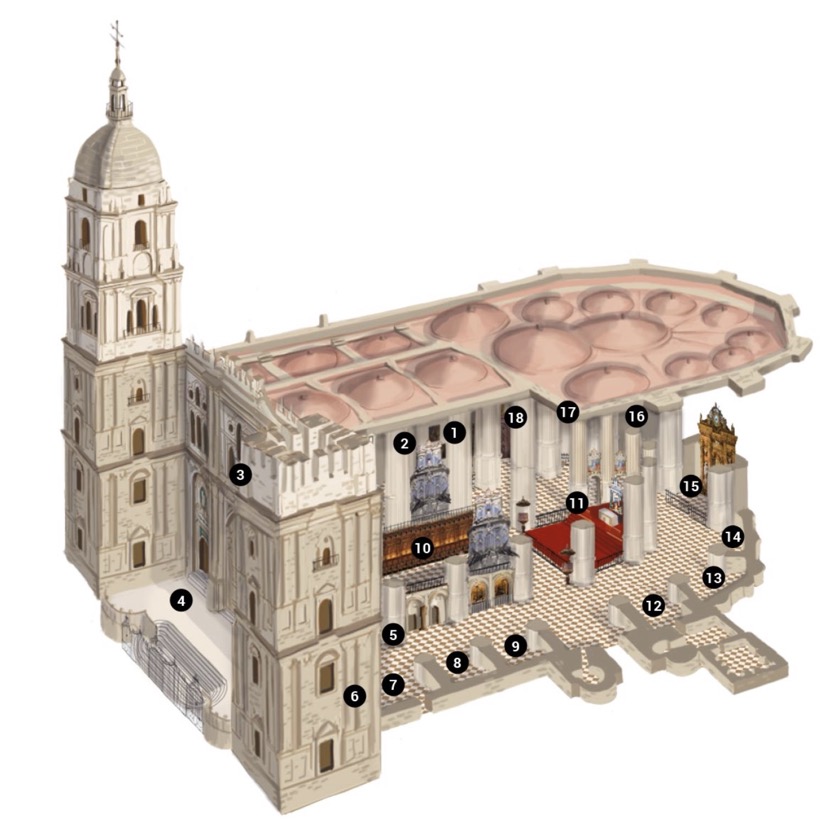 .
.
- Entrance (Puerta de accesso - Crucero Norte)
- Chapel of Saint Rafael (Capilla de San Rafael)
- Chapel of Saint Sebastián (Capilla de San Sebastián)
- External Architecture
- Interior Architecture
- Chapel of Christ of Victory (Capilla del Cristo de las Victorias)
- Chapel of the Holy Heart (Capilla del Sagrado Corazón)
- Chapel of the Virgin of the Rosary (Capilla Virgen del Rosario)
- Chapel of the Immaculate Conception (Capilla de la Concepción)
- Choir (Coro)
- Main Chapel with the Altar (Capilla Mayor)
- Chapel of the Virgin of Monarchs (Capilla de la Virgen de los Reyes)
- Chapel of Saint Francis (Capilla de San Francisco de Asis)
- Chapel of Saint Barbara (Capilla de Sta. Bárbara)
- Chapel of the Incarnation (Capilla de la Encarnación)
- Chapel of the Virgin of the Pillar (Capilla de la Virgin del Pilar)
- Chapel of the Christ of Amparo (Capilla Cristo del Amparo)
- Chapel of Saint Julian (Capilla de San Julián)
Entering the Cathedral
On our visit the entrance was by the north door (no. 1) and that meant that we walked anti-clockwise, following the numbers.
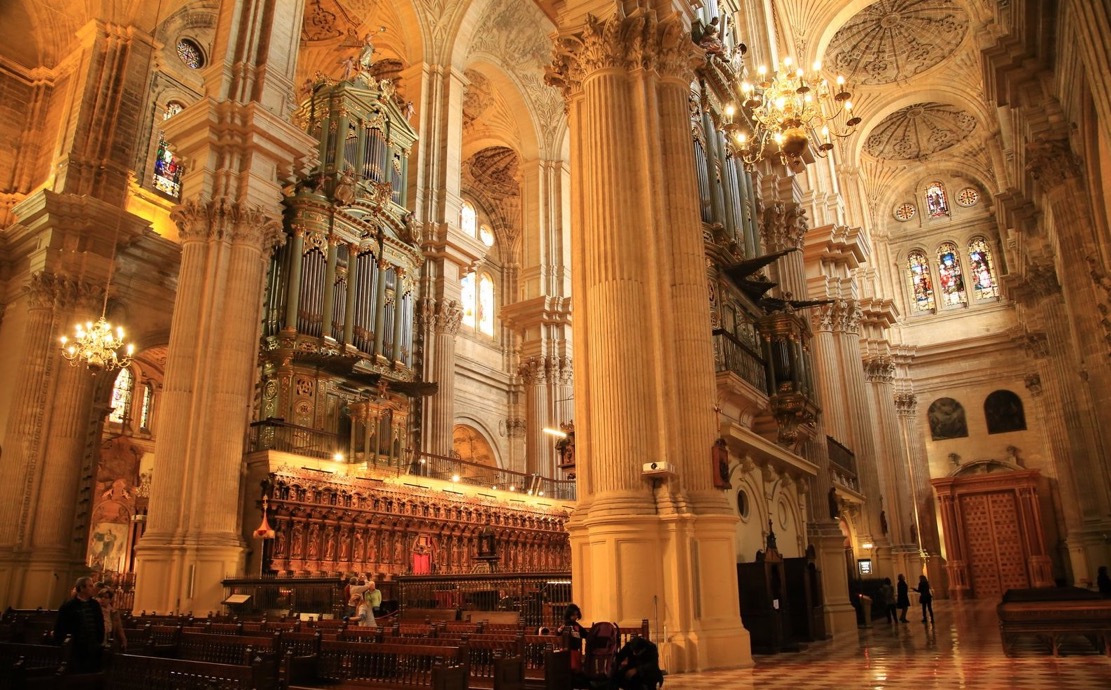
With this photograph (which I found on the Web) I wanted to try to capture that first moment. Feeling the coolness inside the cathedral, and seeing the great stone pillars, the complex ribbed and domed ceiling, all in a kind of golden glow. Truly, quite impressive. Someone wrote that you pass from a fortress outside, dark, heavy and forbidding, and enter a 'living room' inside, all warmth, light and airy.
What we see is what the original builders wanted us to see. A cathedral with the three naves of the same height surrounded by chapels. An ambulatory that communicates with the main chapel through slender arches, and a transept marked by a wider section. The sense of hight and lightness is created by Corinthian columns that support pieces of entablature, and are complemented in height with "attic pillars" on which the vaulted ceiling rests. The aim is a Gothic cathedral that breaks with medieval traditions. The idea was to use what is called a "siloesque" structure, based upon the work of Diego de Siloé (ca. 1495-1563). The decorated spherical caps in the vaulted roof, along with palms, cherubs, etc. give the ensemble a figurative detail more typical of the Baroque period.
In the above photograph we cannot see much of the cathedral that was built until 1588. Based upon cost, and the population of the city at that time, the new Bishop Luis García de Haro y Sotomayor (died 1597) decided to close the nave and transept, and consecrate what had already been built. The closing off, more or less across the pillars we can see above, remained in place for 140 year. However, some work did continue. Four columns were added to create a provisional roof for the splendid walnut stalls that Pedro de Mena (1628-1688) finished in 1662. Most of what we see in the above photograph dates from after 1720 when work began again on the cathedral façade. The work would continue to 1782, where it again would stop for lack of continued funding. But as you might expect, some work still continued. The first of the organs was ready in 1781, and they needed all the hight provided by the pillars topped with the "attic" pillars to raise the ceiling domes.
It was in 1792 that they started again to look for funding to finish the building, and despite efforts in the both the 19th and 20th centuries, the Cathedral has remained unfinished, and has affectionately become known as "La Manquita".
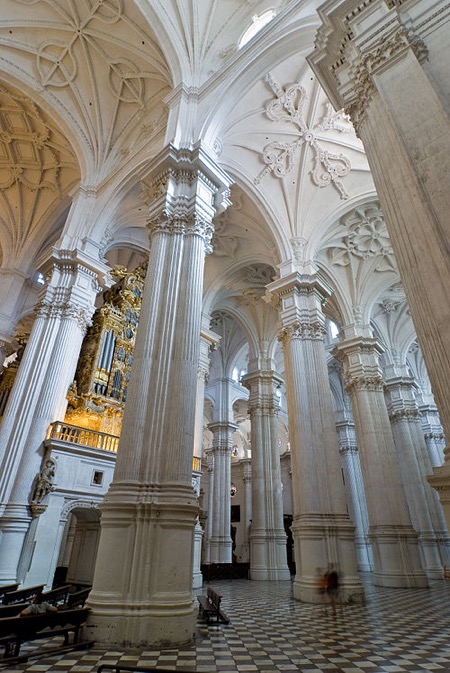
Let's just stop for a moment to look at what a "siloesque" structure really is. Firstly, it's named after Diego de Siloé (ca. 1495-1563), who was one of the foremost Renaissance architects working in Spain in the 16th century. Secondly, it is a style he assumed after his visit to Naples in around 1517, and it echos the work of Filippo Brunelleschi (1377-1446). The example above comes from a Wikipedia photograph of Granada Cathedral (de Siloé spent most of his life in Granada and working on the Cathedral). The style involves large pillars fronted by Corinthian half-columns, and a substantial entablature supporting a second body of "attic" columns which become ribs in the vaulted ceiling. In Spanish texts there is mention of a Brunelleschian "dado", often without any additional information. Yet, it is a specific feature of a so-called "siloesque" structure. So what is a Brunelleschian "dado"?
To describe it properly, we need a little background. One of the original types of structure was a series of columns with a pedestal and a capital, supporting beams on which a ceiling or roof would rest. The column transmits, through compression, the weight of the roof to the floor or foundations. An additional compressive form is the arch, designed to span an elevated space (a vault is a continuous arch forming a roof). There are three very common forms of arches, i.e. circular, pointed, and parabolic. The earliest and simplest form, was the circular arch often exploited by the Romans to span great lengths and/or in the form of an arcade. The foot of the columns could take on a number of elements (e.g. attic base, cornich, etc.) and could sit on a plinth to distributed even more the load. Then you would have the column shaft (e.g. with or without fluting), and on top the capital supporting an architrave (beam or lintel), and eventually a frieze, and maybe even topped with another decorative cornich. To widen the span between columns (which might become piers) and still properly distribute the load of the upper floors or roof, an arch (sometimes called an archivault from arch+vault) could be cast between the columns. The arch would consist of two curved pieces (consisting each of wedge-shaped pieces with an initial springer and voussoirs) sitting on columns (impost) and locked together with a 'keystone' placed at the crown of the arch. Triangular panels would be inserted in the empty spaces formed by the arch and the column, often called tympanum. The structure might support a pediment with tympanum, or eventually a "attic order" wall, e.g. ready for additional columns on a new floor.
Without entering into two many details, columns and arches evolved in many different directions, one of which was the introduction of a "pulvino" (I'm not sure of the English equivalent but it could be a "dosseret"). A "pulvino" is a structural element a bit like an inverted and truncated pyramid, that would be placed between the capital of a column and the impost of the arch. This was often employed in Byzantine architect and it carried decorative motifs, etc. It has a structural value in that it helps direct and convert a lateral tension into a downward compression force on the columns. The advantage is that it helps lift the roof without imposing taller columns that inevitably become thicker and less elegant (and distort the 'canon' or norms of pillar construction). When you know what a "pulvino" is, you can spot them everywhere (sometimes decorated with the cost of arms of a client). Brunelleschi introduced them in ca. 1420, and they became (improperly) called Brunelleschi's "dado" (because of its cubic form). Siloé adopted this "dado" in the form of a quadrangular upper pillar sitting on a substantial entablature with Corinthian half-columns, and supporting the vaulted ceilings (as seen in the photograph of Granada Cathedral).
Chapel of Saint Sebastián (Capilla de San Sebastián)
I noted an interesting comment about Saint Sebastian, that called him the "Christian Apollo" because he is one of most reproduced saint. But more importantly this chapel is home to the life-size el Crucificado del Perdón, by Pedro de Mena (1628-1688), who is still considered one the most skilful sculptors of religious statues in Spain.
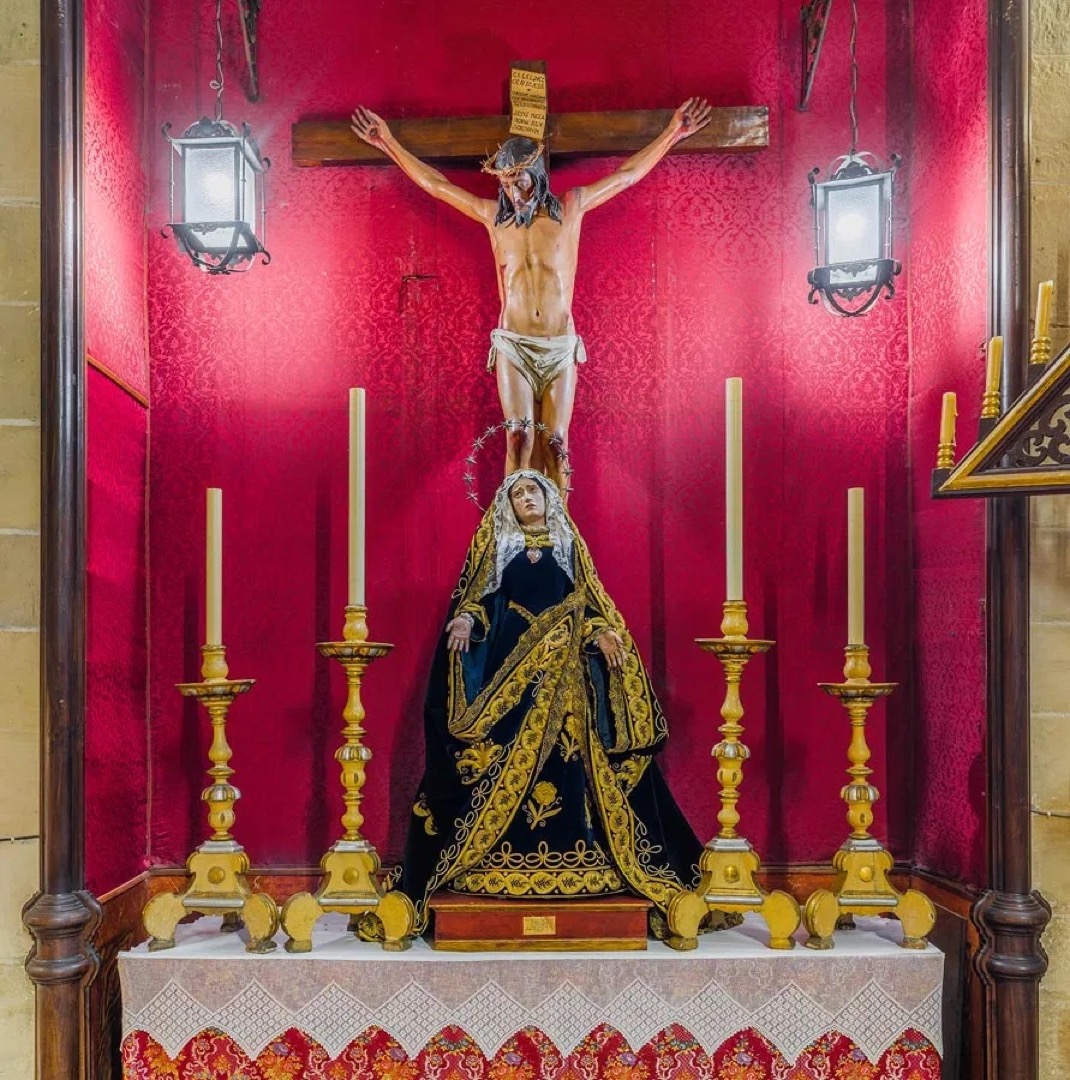
The crucifixion is a central theme of Christian art, with the cross and the body of Christ. Initially highly stylised and codified it gradually became more realist and humanised, finding (in the opinion of many experts) its fullest expression in the Spanish baroque. We have here an anatomical exercise, in which we see someone who was tormented and who suffered. Some see something more, an ascetic-mystic presence. Everyone agrees in seeing supreme technical skill.
Chapel of the Holy Heart (Capilla del Sagrado Corazón)
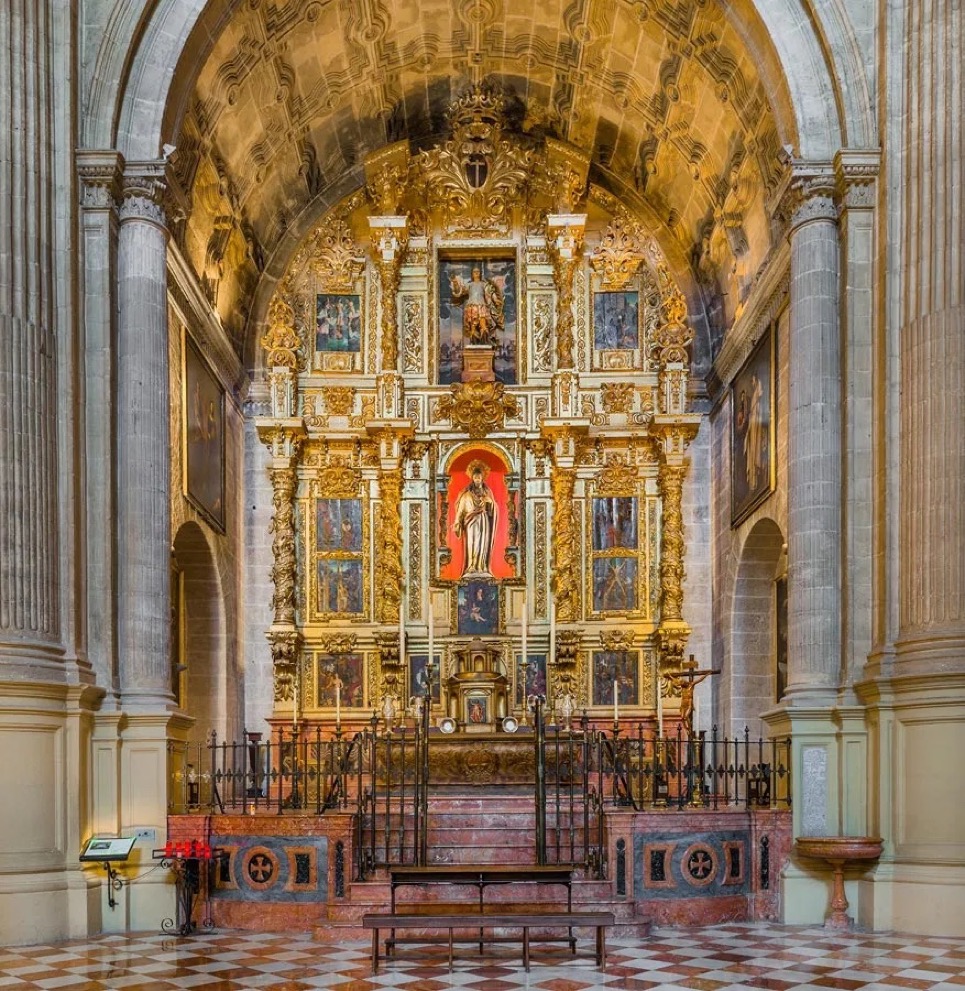
We have a Baroque altarpiece representing the life and martyrdom of Saint Pelayo. The 18th century gilded wooden altarpiece was installed after the civil war, and came from the Church of San Pelayo in Becerril de Campos. It is home to eleven 16th century paintings dedicated to both Saint Pelayo and others such as Santa Águeda. They have been attributed to the "Master of Becerril".
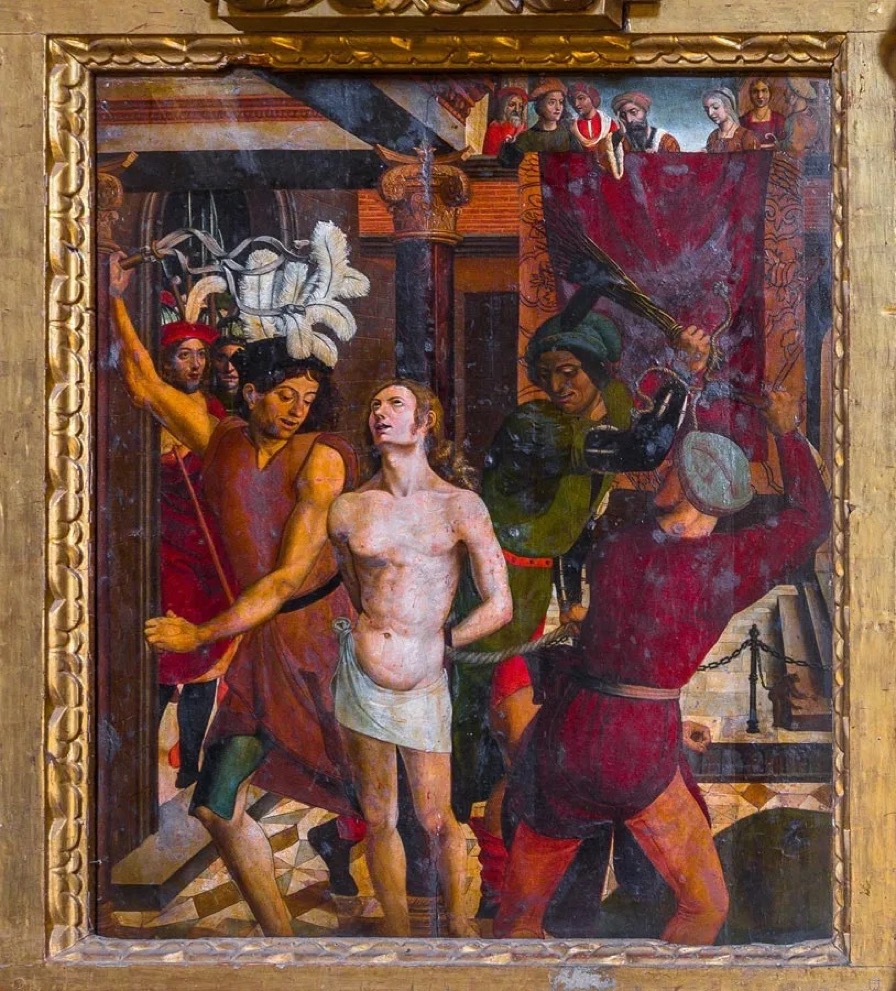
Saint Pelayo (Pelagius of Córdoba, ca. 912-926) was a Christian boy who refused to convert to Islam, and was tortured and dismembered, or decapitated (depending upon the version).
Castilian painting of the early 16th century largely rested on the shoulders of Pedro Berruguete (ca. 1450-1504) and Juan de Flandes (ca. 1460-1519). Berruguete is often considered the first Renaissance painter in Spain, and de Flandes was a Flemish painter (name unknown) who, from 1496, became an artist at the court of Isabella I. In later life Berruguete did some of his best works in different places in and around Palencia. Also after the death of Isabella I, de Flandes went to Palencia to execute paintings for the high altar in the cathedral. He stayed there until he died. Some experts have suggested that the "Master of Becerril" might possibly have been Juan González, the son-in-law of Berruguete. In any case the "Master of Becerril" appears to have been one of a number of painters indebted to de Flandes for their technique, and equally he has been considered a follower of Berruguete in terms of adopting new Italianising forms and compositions.
In the central niche we have the Sagarado Corazón de Jesús, a work by the Málaga born Francisco Palma Burgos (1918-1985). This replaces the previous statue that was destroyed in 1940. The artists was best known for religious themes, for respecting Baroque traditions, and for focussing on a more sensitive and expressive attitude, rather than the dramatics of Castilian imagery.
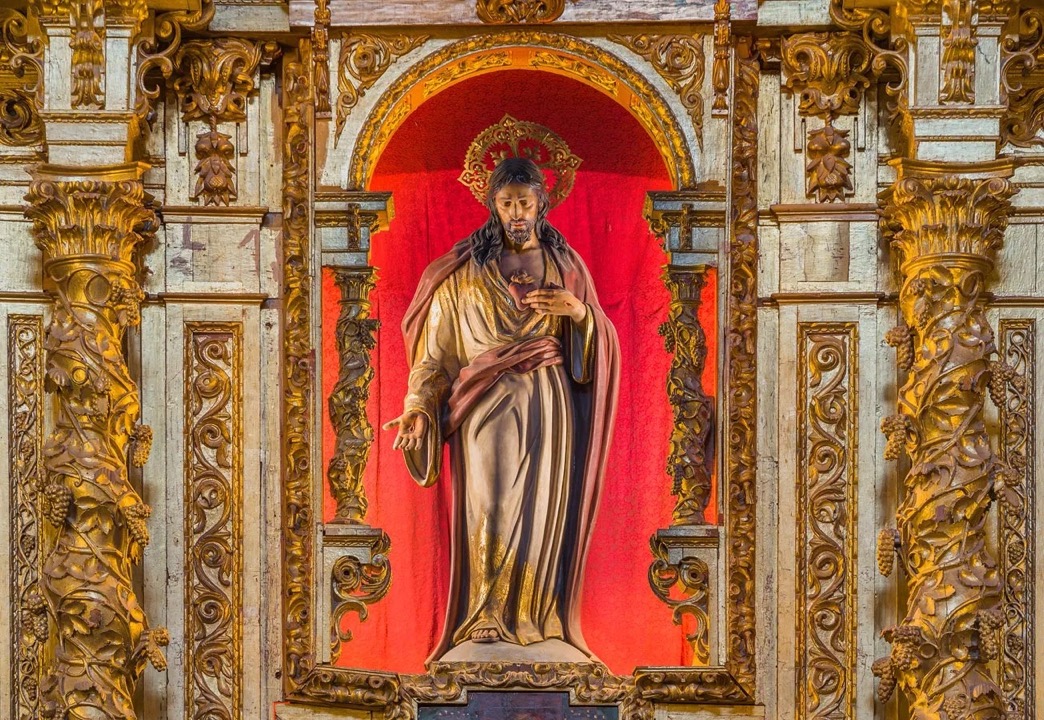
The Catholic devotion to the Sacred Heart is one of the most popular and most widely practiced, and it derives from the devotions to the Holy Wounds. In this case it refers to the final wound to the side of Jesus' chest, where his body was pierced by a lance, and blood and water poured from the wound. The popularisation of this devotion derives from a French Roman Catholic nun, Saint Margaret Mary Alacoque (1647-1690), who is said to have learned the devotion from Jesus during a series of apparitions to her between 1673 and 1675. The devotion began in the first decades of the 18th century, but was only approved by Pope Clement XIII (1693-1769) in 1765.

The Sacred Heart is usually depicted in Christian art as a flaming heart, pierced by the lance-wound, encircled by the crown of thorns, surmounted by a cross, and bleeding.
As you can see in the above photographs, a Baroque altarpiece is a very substantial piece of work, and I'm going to try to describe just what 'substantial' actually means. We don't have any information on the rebuilding of this particular altarpiece, but we do know a lot from other altarpieces of the same period. As you can see altarpieces can be very large three-dimensional, free-standing, pseudo-architectural constructions, often exceeding 15 metres height, 10 metres wide, and 4-5 metres deep. Some can be accompanied by additional sculptured elements situated in front of the main piece. Many followed the proportions laid down in a treatise on architecture by the Italian Giacomo Barozzi da Vignola (1507-1573). There were periods when altarpieces were purchased by local authorities with limited budgets, and constructed by small-time craftsmen of limited skill. But there were always a few rich authorities who wanted spectacular pieces, dripping in gold, and made by the finest craftsmen.
The altarpiece can be viewed as a product of one of three different periods. The first period lasted until 1670-1680, and involved a pious narrative expressed through numerous panels with relief carving. The better examples were often inspired by Italian engravings of the late 16th century. The second period, lasted until 1730-1740, and often showed the presence of the Solomonic columns (helical or corkscrew columns). We are in the period of the Counter-Reformation (ca. 1545-1648), and the narrative was more about salvation, and with the figure of Mary the Immaculate or the Blessed Sacrament acting as the centre point (and patron saints were relegated to lesser panels). To overcome the challenge of the Protestant Reformation (ca. 1517-1648) the emphasis was on altarpieces brimming over with glory and triumph. The third period brings us to the end of the 18th century, where the traditional altarpiece came back into favour, as did large canopies, and Rococo ornamentation.
The materials used are normally wood, stucco, and paint, and the internal construction can be very complex. The altarpiece is usually built up from modules, each consisting of a wooden box as a frame and filled with sub-components. There could be 5 or more modules representing both horizontal and vertical components, and all probably manufactured is a workshop and transported to the church for installation. The modules could be made of pine, and they would be locked together using oak wedges placed at the top and bottom of each module. Each of the large modules would act as a frame to hold 10 or more sub-components that would fit together by keyed mortise and tenon joints.

In one altarpiece there were 38 sub-components, some of which would be connected to the back wall using iron beams. Some stucco parts would be pre-cast in molds and fitted to the altarpiece, and some stucco would be added by freehand modelling.
Free standing columns would often consist of hollow components making up the shaft, plus bases and capitals, all fitted together with wooden dowels. Some columns have been shown to consist of up to 60 wooden parts.
Stucco components would be attached to wooden sticks going though the sculpture and into the supporting modules. Those horizontal sticks might have metal reinforcements. There would be pre-cast stucco components that would be finished off by hand in-situe. The stucco would often start with a coarse mortar applied to a rough surface layer placed on a wood support. Then a fine plaster layer containing fine aggregates of sand would be applied over the mortar. It was this second layer that would be finely modelled, e.g. for hair and drapery.
Painting would be added, but in many cases a white surface layer was added later when the altarpiece was repainted. If the altarpiece had been disassembled and rebuilt, there could be numerous additions and modifications to how it was originally constructed. Bits could be modified if the altarpiece was found to be too tall or too short, etc. (top elements could be removed or the base shortened). Also if moved, the modules could be fixed together again with nails or screws, usually without any respect for the original building technique.
Initially ancient gilded surfaces were made of pure gold beaten out to from a leaf, or as a powder mixed with an organic binder. In medieval times, other metals were introduced, such as silver leaf, or alloys of gold and silver with precious metals. Goldsmiths could produce alloys with different colours and with improved properties such as strength, hardness, ductility, etc. Two techniques were common, water and oil/mordant gilding using leaves of gold or alloys imitating gold, or metallic powders mixed with a binder. Mordant gilding has a yellower, more matt surface than water gilding. The surface had to be prepared using "Armenian bole" (earth pigments) over a gesso ground. The colour of the bole could change the appearance and chromatic hue of the gilding. The water gilding technique was usually employed when the gold was to be burnished and decorated by punching. The metal leaf would be laid onto an adhesive layer of soft iron-containing clay (bole) mixed with animal glue. The bole layer imparts a warmer colour to the thin gold leaf and provides a good, smooth cushion for when burnishing the gold layer.
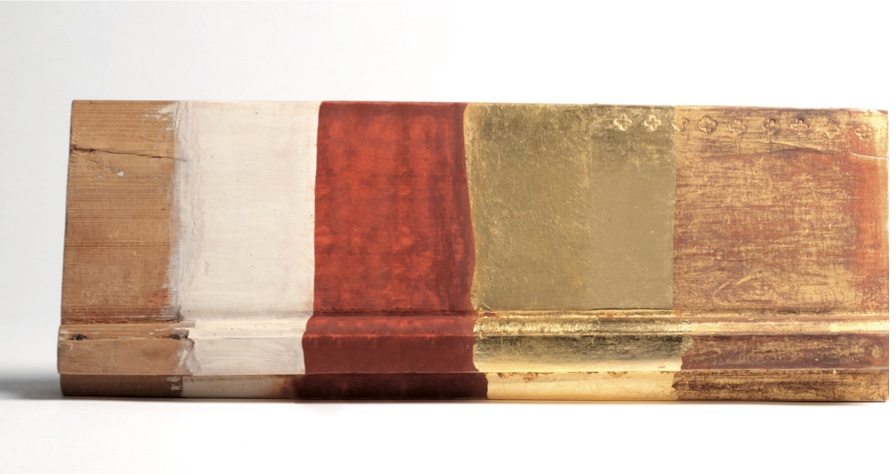
Above we have water-gilded wood, showing the preparation layers, from left to right, wood covered with glue, then white ground, red bole, gold leaf, burnished gold leaf, and finally artificially aged gold leaf.
In the gilding with mordant the bole was substituted by an oily-resinous mordant (e.g. linseed oil mixed with pigments as driers). Occasionally varnish was added. This type of gilding was usually employed for small details of carved wood, but not when the surface was to be burnished. Another type of gilding was gold in power mixed with varnish, gum arabic, or animal glue, and applied by brush. If the gold was too expensive, then a technique called "mecca" was used. The gold leaves where replaced by silver ones and then varnished creating an imitating gold surface. In the Renaissance period there was a technique called "estofado" where the gold or silver were overpainted with colour paints to imitate precious textiles, damask and brocades. The technique was to paint over the gold leaf, then scrape off before it was completely dry, revealing the gold beneath. In Spain they also mixed silver with an alcohol-based varnish to imitate gold, and this was used during both the Baroque and Rococo periods.
Chapel of the Virgin of the Rosary (Capilla Virgen del Rosario)
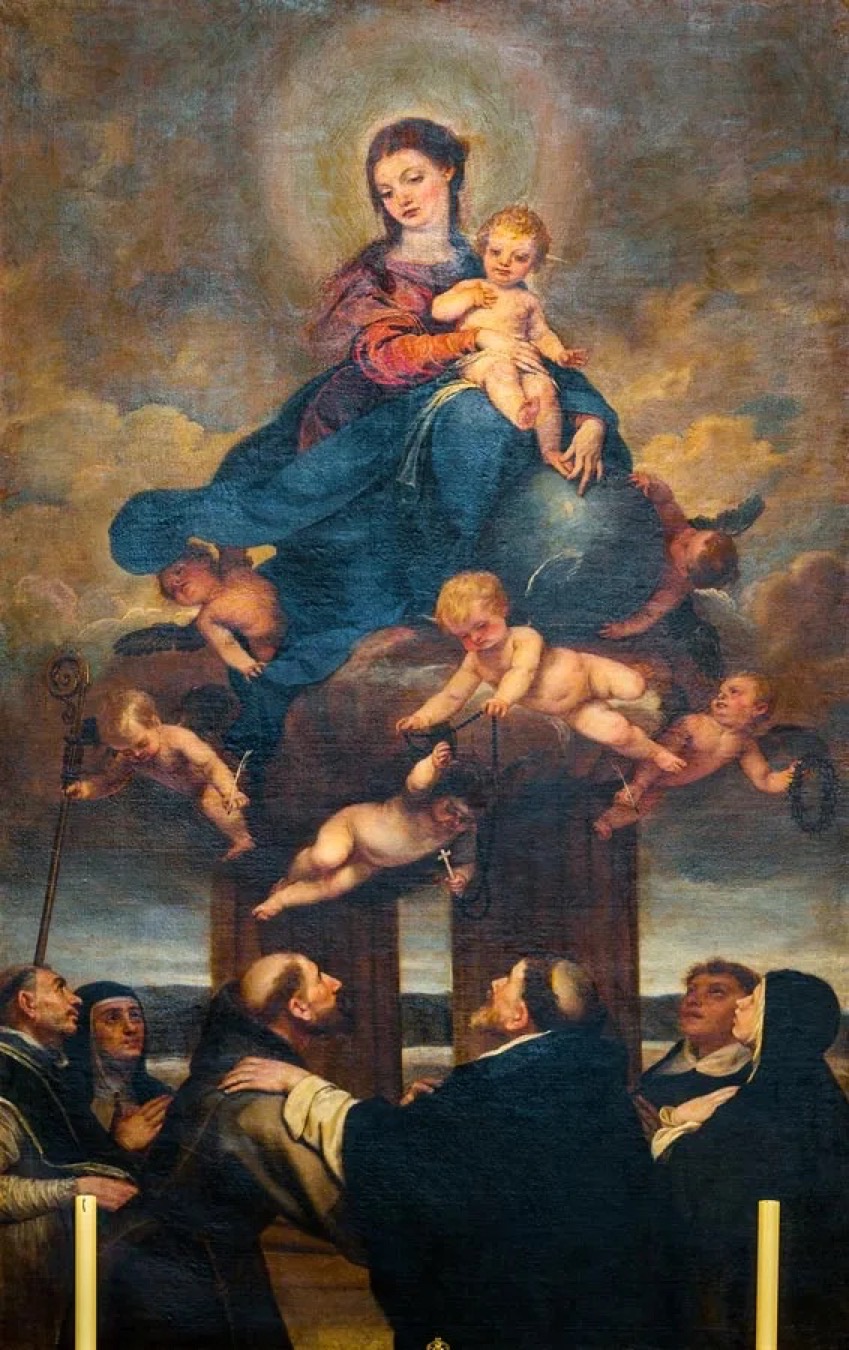
The star of this chapel is the 'Virgin del Rosario' by Alonso Cano (1601-1667), dated to 1665-66. Cano was made first royal architect and painter to Philip IV (1605-1665) and was architect of the façade of Granada Cathedral. One story is that he was condemned for murdering his wife, but he fled. He then returned to Madrid, was put to torture, which he endured without incriminating himself, and he was received back into the kings favour. After his wife death he took Holy Orders as a protection from further prosecution.
Choir (Coro)
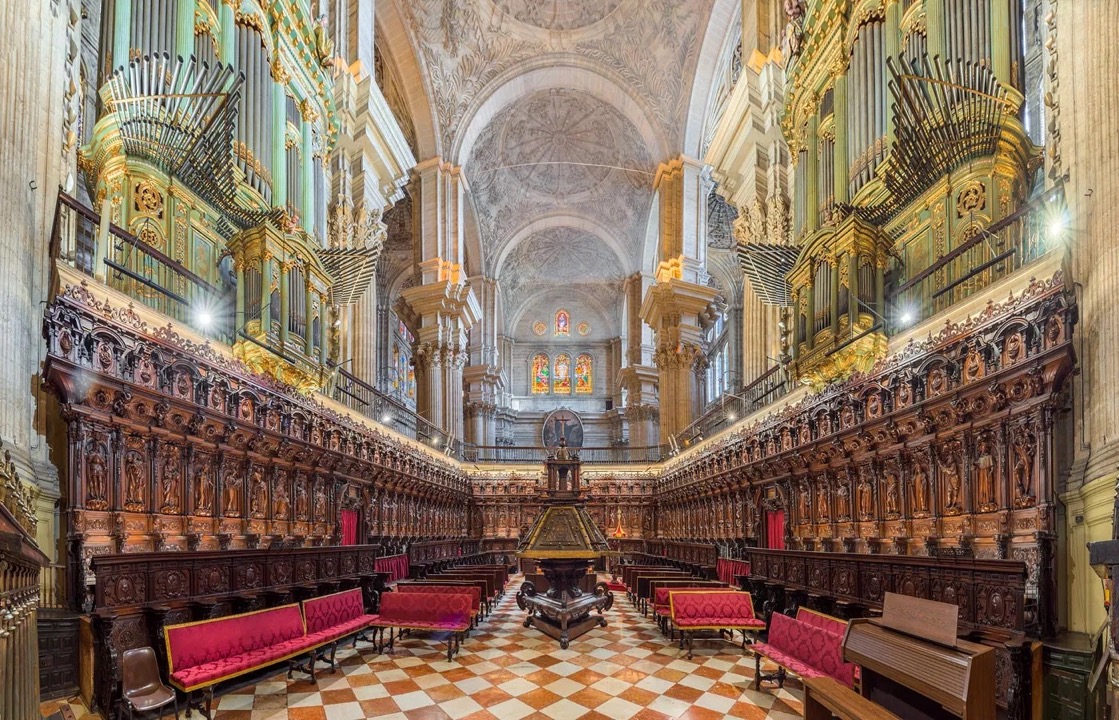
The chorus (coro) is considered one of the most important sculptural ensembles of 17th century Spain Baroque. What we can see is a choir-stalls (sillería del coro) on three levels.
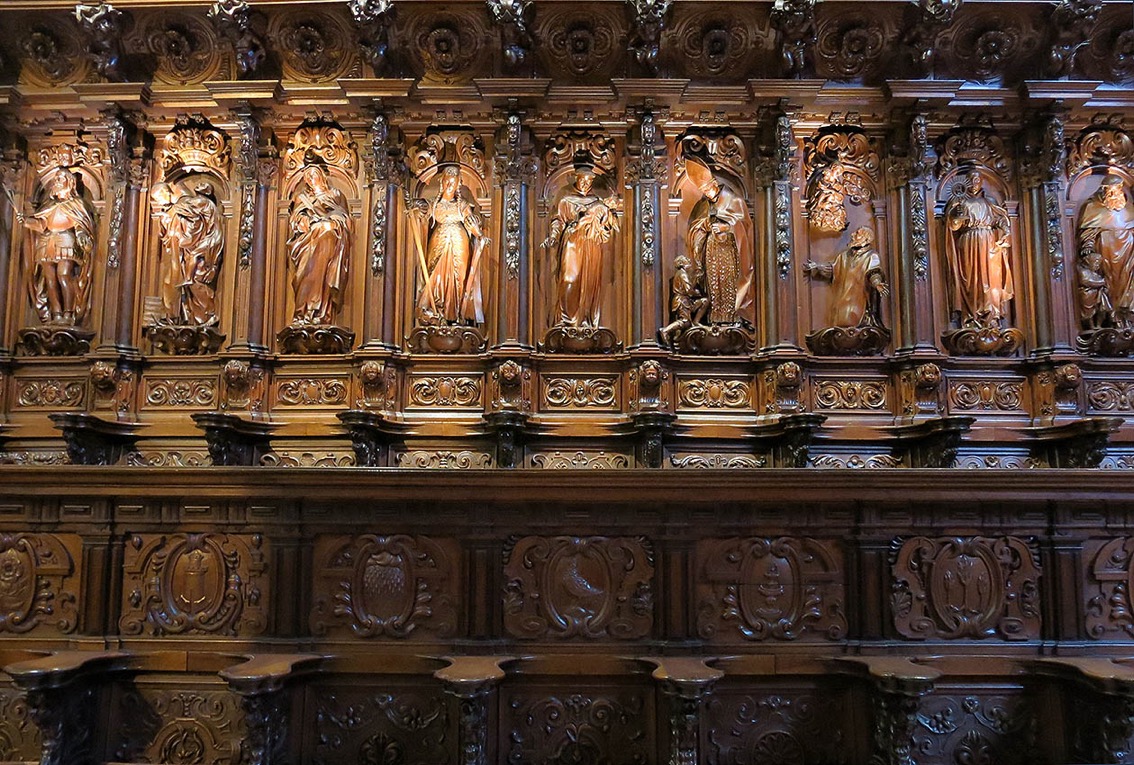
Firstly there are 44 front stalls that you might call ordinary, at least as compared with the high stalls. They have elaborate sculptured backs with the Virgin Mary, the Evangelists, as well as a wide range of Saints, etc. The third row is just a line of female faces, topped with heraldic crests.

The work was started by Luis Ortiz de Vargas (ca. 1588-1649), who won the first contract to carry out the work in cedar and mahogany. He worked on the choir seats between 1633-1638, and the above example of the Bishops seat with the Virgin, Saint Peter and Saint Paul is his work. The decoration is geometric, with plants, animals and allegoric symbols, and well as male and female heads. He also was responsible for the general architectural layout.
Between 1638-1649 it was José Micael y Alfaro (1595-1650) who then continued with a large part of the ornamental reliefs, and including the backs of 13 high stalls. With the death of Alfaro in 1650 the work stopped for 8 years. The statues of Alfaro are often considered the true reflection of the Malaga Mannerist style.
The major part of the work would finally come from Pedro de Mena y Medrano (1628-1688) in 1658, who completed the remaining 40 sculptures. His fee was 40,000 reales, so 1,000 reales per stall. This included a home for his family and team, and a workshop. He finished the work in 1660, but two additional saints were added, one in 1678 and another in 1680. Experts tell us that Pedro de Mena's work is more realistic and at the same time extraordinarily elegant. He added a wide repertoire of ages, clothing, textures, embroideries, as well as gestures and expressions. Below we have San Basilio, San Elías and San Jerónimo, and below them we have the facial details of San Bruno and San Roque.
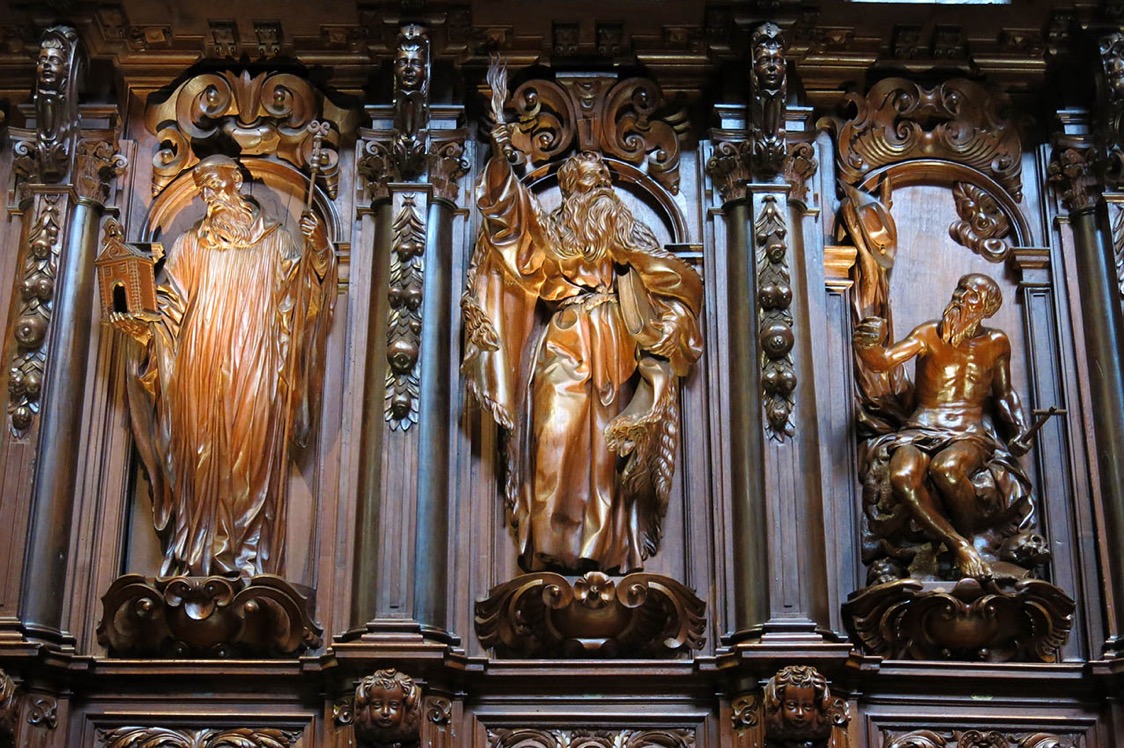
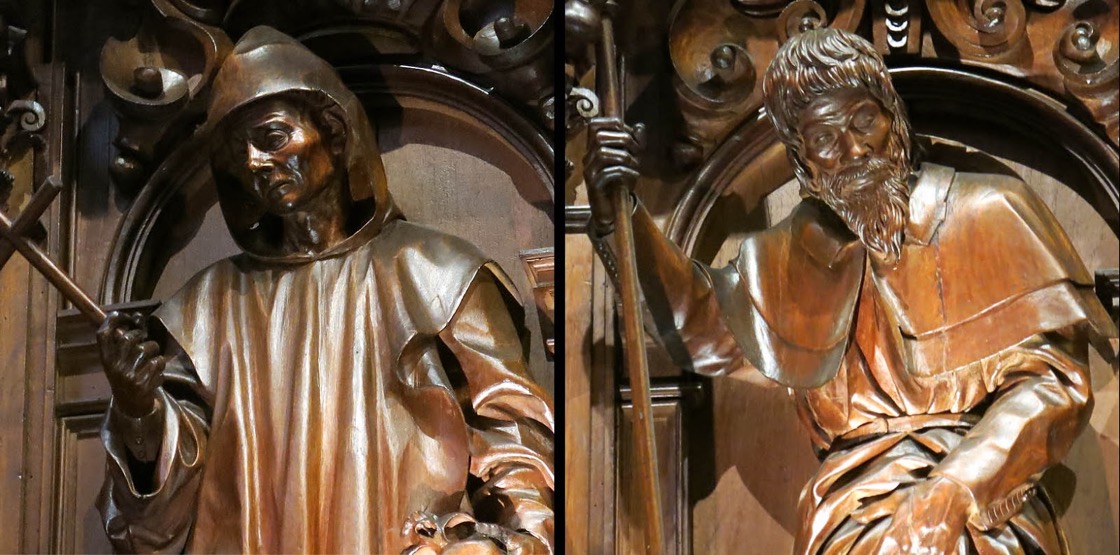
Which musical instrument has often been called the "crowned king"? Which instrument is the largest, most complex, and perhaps the most fascinating of man-made sound machines? The church organ is said to have been around since the 11th century, but by the 16th century it had certainly found its place in all the more important cathedrals and churches in Andalucía. The organ is the only instrument that can truly fill the space created within a church, and at the same time because an organ is a true example of architecture, it has both sound and visual dimensions. Often the organ was so much part of the churches architecture that it was not even mentioned in the inventories and guides of earlier times. Yet today there are 250 organs currently catalogued in Andalucía (30 in Seville alone), and who knows how many have been lost over the first half of the 20th century. So 250 organs, but many in a state of disuse or even abandonment.
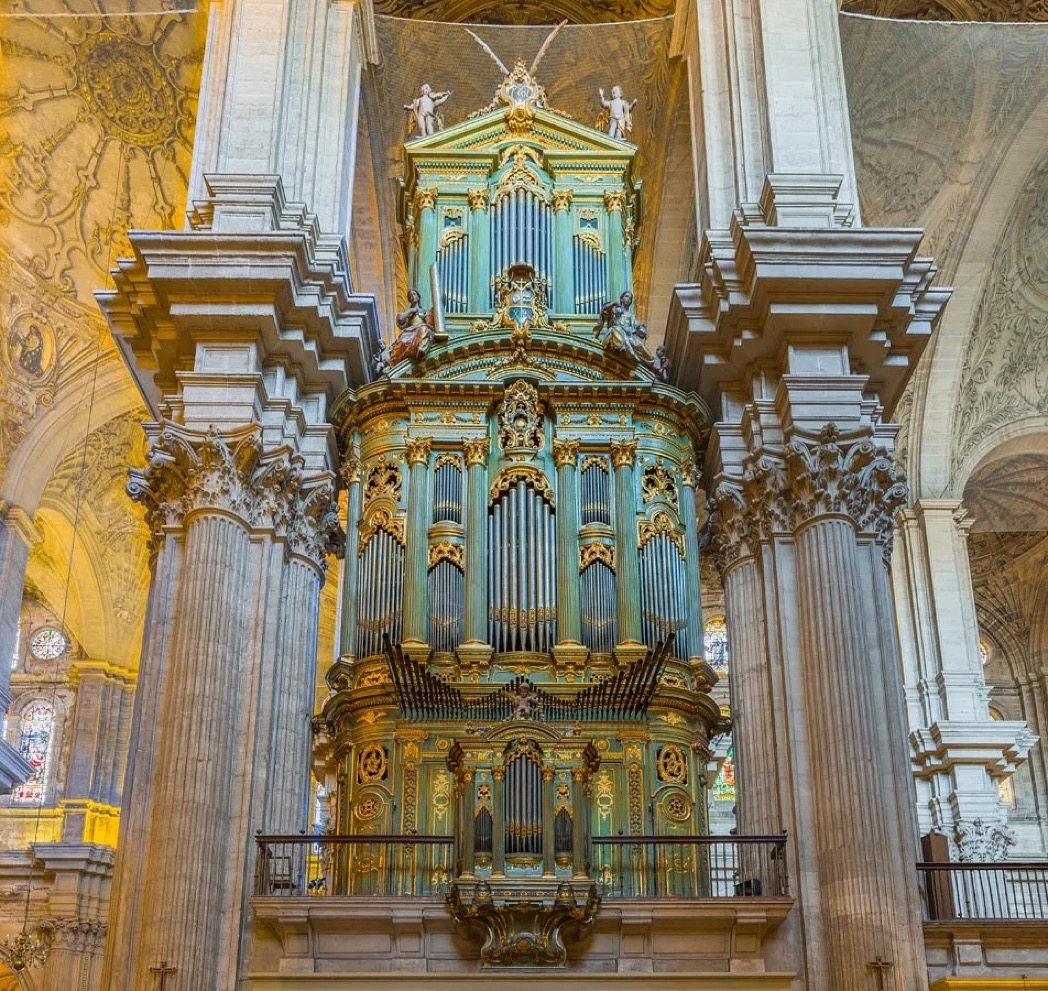
One often forgotten feature of an organ is that its original construction depended not only on the technology and techniques of the period, but also depended upon the current musical theory of the time. Of course this is true of any musical instrument, however the novelty is that organs are not just now museum pieces, but are instruments used almost every day. In many parts of Spain, 18th century organs outnumber those built later (some of which are only copies of earlier organs). Some organs fit into small spaces and have a few hundred pipes, Málaga Cathedral organs have 4,537 pipes, whereas the Cathedral of Passau had 17,774 pipes. In Málaga only 376 pipes are located vertically on the outside of the organs, and another 510 are placed horizontally. Each pipe can only produce one sound, so in theory you need a key on a keyboard for every pipe. In addition you can change the timbre and texture whilst still playing the same keys. The timbre depends on the material of the pipe (metals, alloys, even wood), the shape, and if they are covered, open, semi-open, etc. Another interesting feature is that the "quality" of the sound of each pipe is dependent upon it receiving just the right air pressure from the bellows. But the air produced by the bellows is stored in a common reservoir, so the art of the builder is to deliver the right air pressure to the right pipe, given that in Málaga the smallest pipe is a few centimetres long, and the largest 6 metres long and weighting 67 kilograms. And remembering that organ builders of 18th century had not studied physics, acoustics, or mathematics. Málaga's organs have three keyboards, plus 107 'registers' that select the timbre and texture of the sound (see below). With a piano the keys are "attached" to the hammers that hit the strings, however an organs keyboard is not attached to a pipe. Today modern organs use electrical contacts, but originally each instrument would have had its own delays or "weight" as a function of a forest of wooden rods (see below) that would connect the key to the pipe a few metres away. And of course the registers would have had their own separate forest of rods. And finally, for the same musical score, each instrument plays and sounds different.
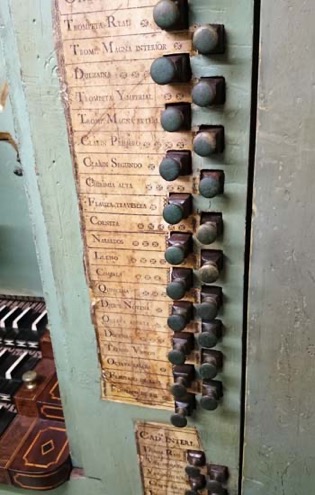
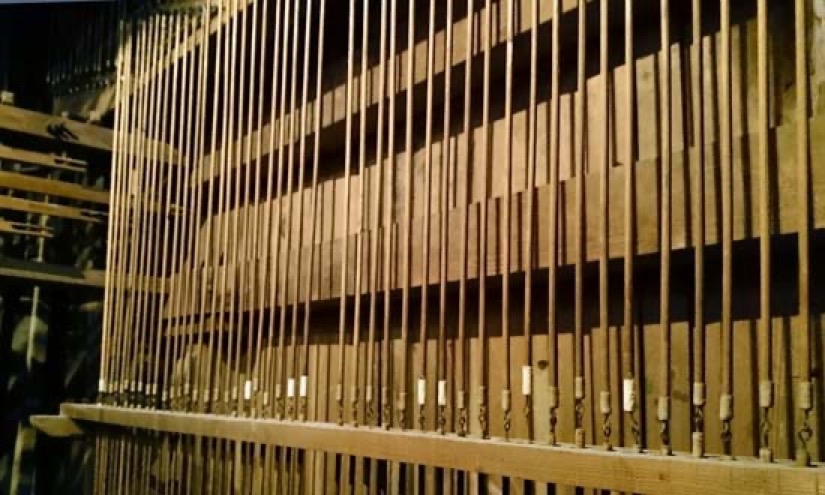
As one organist put it "The best Cathedral is not the one you see, it's the one you hear", and fortunately the organs in Málaga Cathedral are in an excellent state of repair. Alongside the organs, Málaga has a very large music archive of 3,000 pieces from Gregorian chants to a group of more than 1,000 Christmas carols (all preserved in one of the towers). Almost a thousand of these bear the signature of Juan Francés de Iribarren (1699-1767), a chapel teacher in Málaga for 34 years. The cathedral is home to the two largest Spanish Baroque organs still existing, and it was José Barrera (1729-1788) who added to the collection works for two organs. The two organs presently in the cathedral are identical to those first installed in 1782, only the manual bellows have been replaced by automatic blowers.
There are suggestions that an organ already existed in the cathedral, when a new one was order for 500 ducats in 1599. In 1651 there was news of another organ being built. This new organ had to be repaired in 1733, and again in 1765. So, yet again, a new organ was planned starting in 1768. But it was Bishop José Molina Lario who decided in 1776 to go ahead, and in 1777 he obtained permission to start on an organ that should not cost more than 12,000 ducats, to which he added 3,000 ducats to make a budget of 15,000 ducats. The choice fell on an organ builder who had already a proven track record with the organ in the Cathedral of Cuenca, a certain Julián de la Orden. We need to distinguish between organ builder and the architect that might finalise the construction, i.e. the organ builder actually builds the boxes with the organ pipes, and all the associate mechanics such as keyboards, bellows, etc. but not necessarily the structural and decorative compositions that we see in a church. In fact it was a certain Martín de Aldehuela (1729-1802), a name we will see again later, that took charge of the actual architecture of the organ in Cuenca Cathedral.
Julián de la Orden came to Málaga without a prior design, but once put on paper it was so convincing that the Bishop Molino Lario decided to pay himself for a second organ. A contract for 24,000 ducats was signed in November 1778. At the time they were prohibited to put private objects, etc. in the cathedral, so they simply kept quiet about the bishops investment (the only indication was that one organ would carry his arms). The first organ was finished in December 1781, however it turned out to be more expensive that originally envisaged, and ended up costing an extra 50,000 reales (the second was finished in December 1782). Already the bodies of the two organs had been enlarged, but in 1780 it was decided to change the façades and ensure that both organs looked and sounded the same. Also another investment of 7,090 ducats led to the use of a single set of keyboards for the two organs. In fact the two organs do sound a bit different in that one organ has a set of small flutes (pífano) and the other a set of German flutes (flauta Alemana), although my guess is that to the untrained ear they probably sound the same.

For the new organ bodies they turned to Martín de Aldehuela in 1778 (he had originally recommended Julián de la Orden as the organ builder). Despite costing 30,000 reales the bishop was so pleased with the architecture of Martín de Aldehuela that he gave him 500 reales more. Martín de Aldehuela went so far to lift the "attic pillars" in the nave to create more hight for the 22 metre tall organ bodies. Experts see the design as having a "Baroque spirit", but with a tendency toward a future Neoclassicism. On a practical level, what Martín de Aldehuela managed to do was to integrate what previously appeared as three separate bodies per organ into a single decorative composition. So he designed the organ structure, but it was Juan de Salazar and Antonio de Medina who prepare the structure and sculptures, etc., which were the painted and gilded by José Romero and Gregorio Ortíz (who must have done the majority of the work because he was paid 720,000 reales). José García was the carpenter and Francisco de Vega the blacksmith, but working under the command of Martín de Aldehuela. The total cost of the two organs was estimated at 60,000 ducats.
Main Chapel with the Altar (Capilla mayor)
We are now going to try and 'sneak up' on the main chapel (Capilla mayor). As you will see this is not going to be easy. So we will start by sitting "at the back" which is in fact over the top of the puerta principal (not used because the present entrance is a side door).
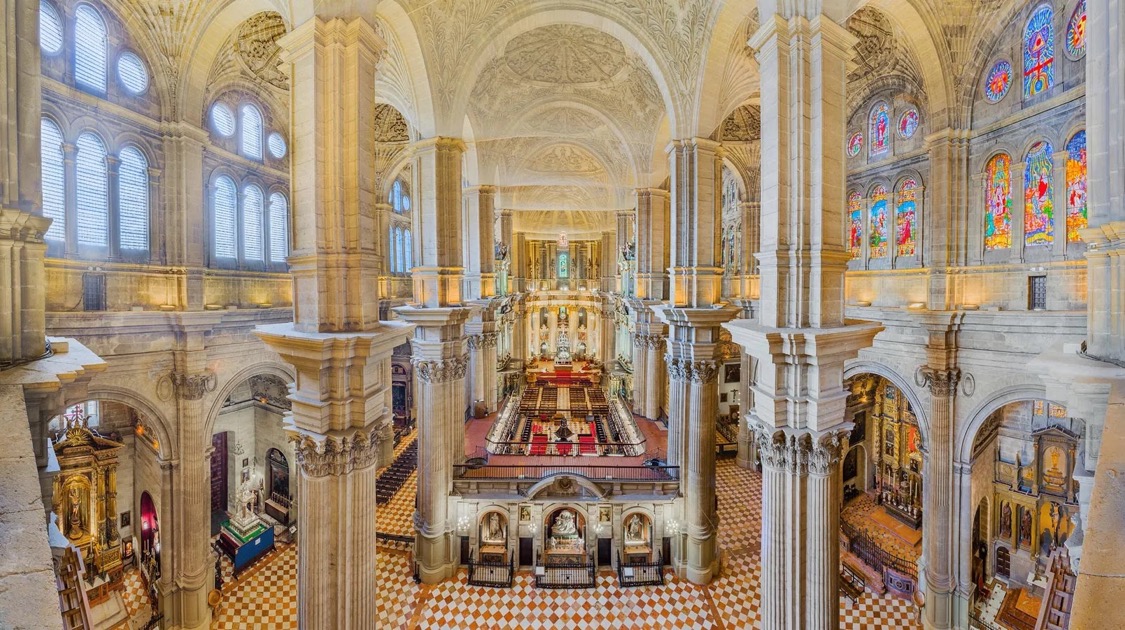
Now we have floated down to the floor and are standing in front of the retrochoir (trascoro), where in the Capilla del Trascoro we can just about see a Pieta (La Piedad) in Carrara marble by the brothers Pissani, from Florence (dated 1803).
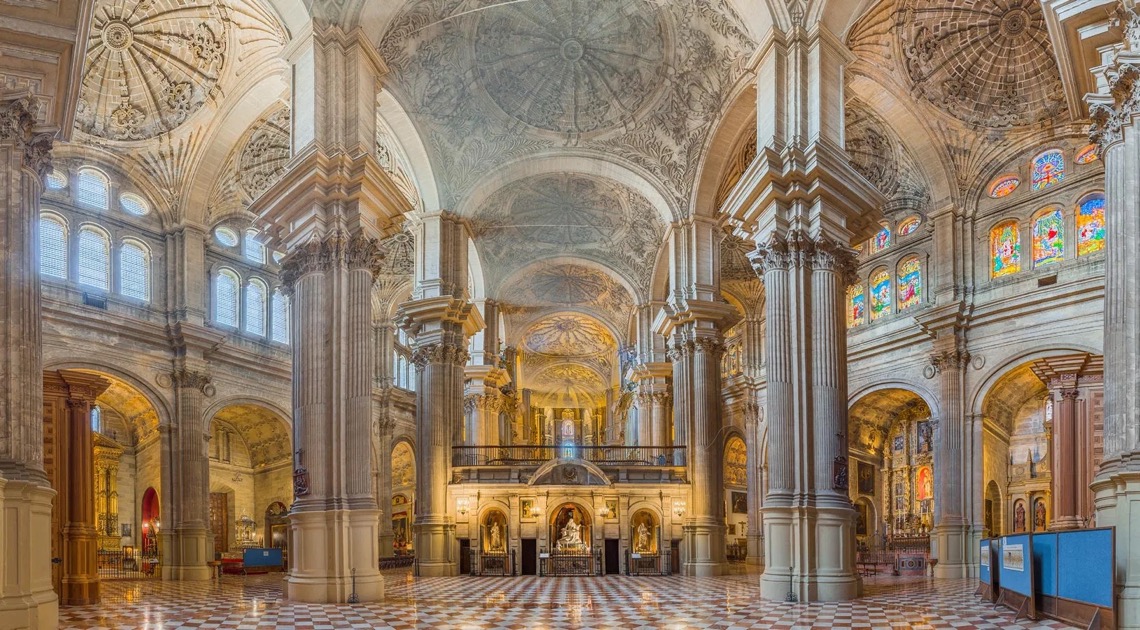
We can see on our left and right the naves that are such an important feature of this particular Cathedral. They are wide and have the same height at the central nave, and are also full of light.
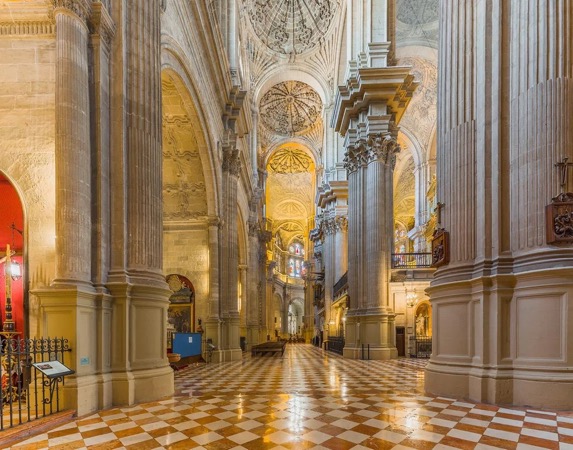
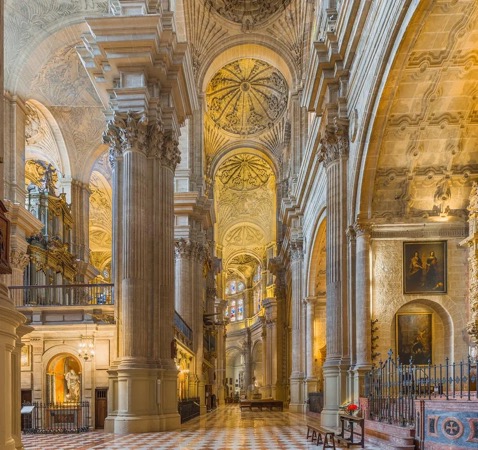
We have moved forward and can see the choir (coro) before us …
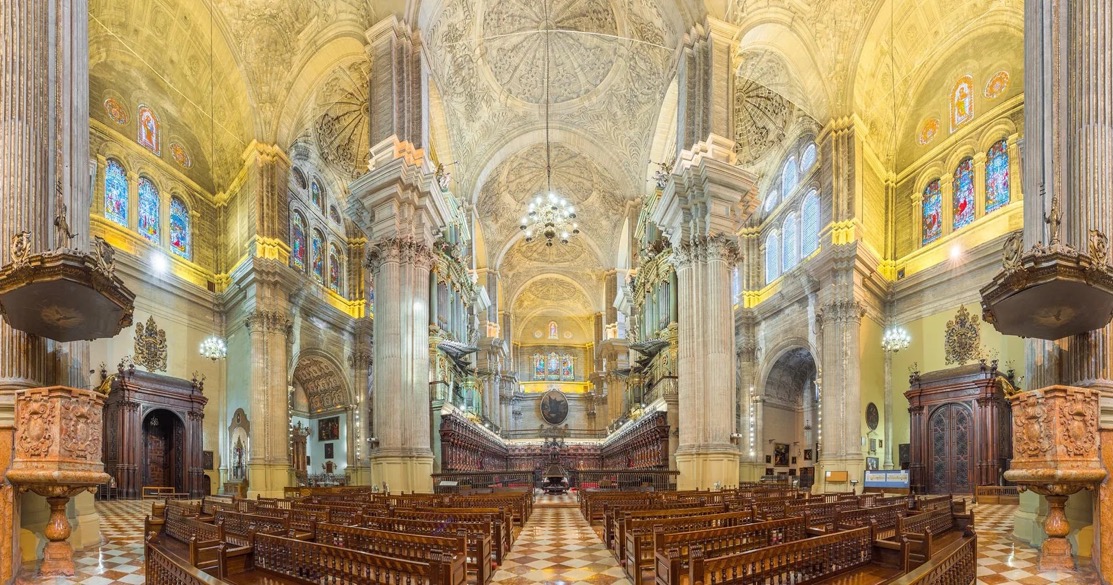
We now fly over the choir (coro) …
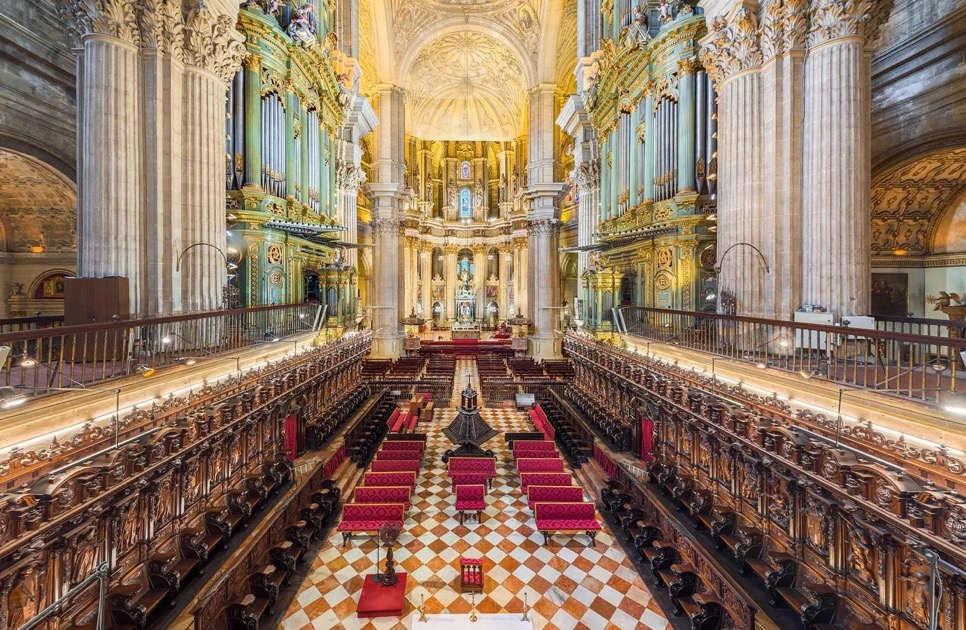
Finally, we now stand in in the transept, and we can just see the two red marble pulpits designed by Fray Juan Bautista Maíno (1581-1649) and made by Melchor de Aguirre (1640-1697) between 1674 and 1677.
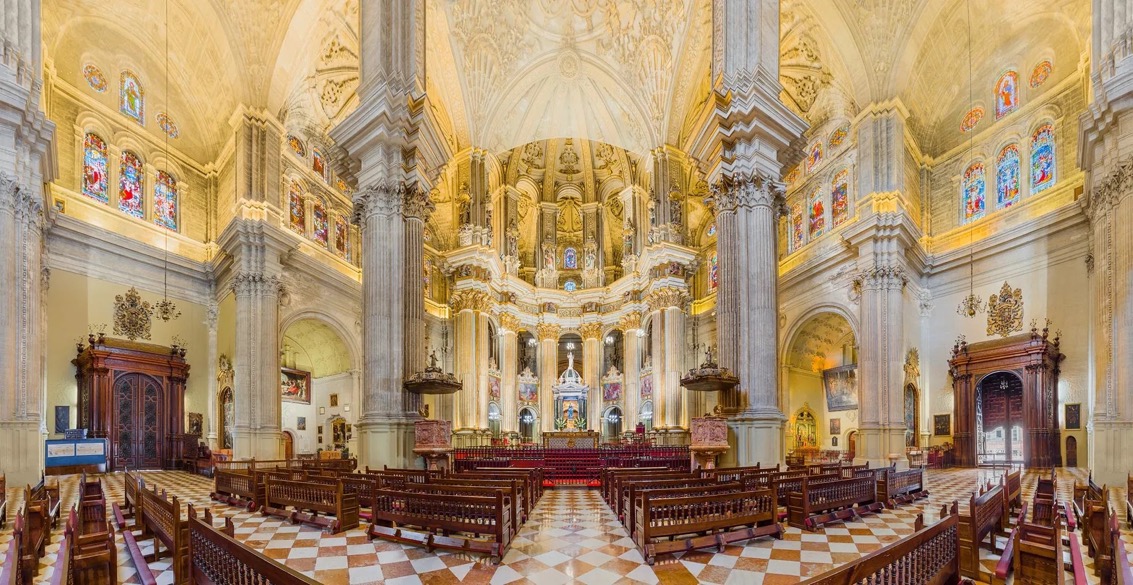
The Altar mayor, the central altar, was designed in 1541 by Diego de Vergara (1499-1583). It is a semicircular series of six tall fluted Corinthian columns topped with a beautiful ribbed vault. The rest of the interior is also covered by ribbed vaults decorated with grotesques and palms, the sense of elegant height already shows a break with traditional Gothic architecture.

The five paintings were executed in-situe in 1587 by the Italian painter Cesare Arbasia (ca. 1547-1607), and they represent various episodes of the Passion of Jesus Christ. At the time they cost 3,500 ducats.
It was the son of Diego de Vergara who in 1588 closed the ends of the transept with a masonry wall, and built the steps to the high altar and side doors. The wall remained in place for 140 years.
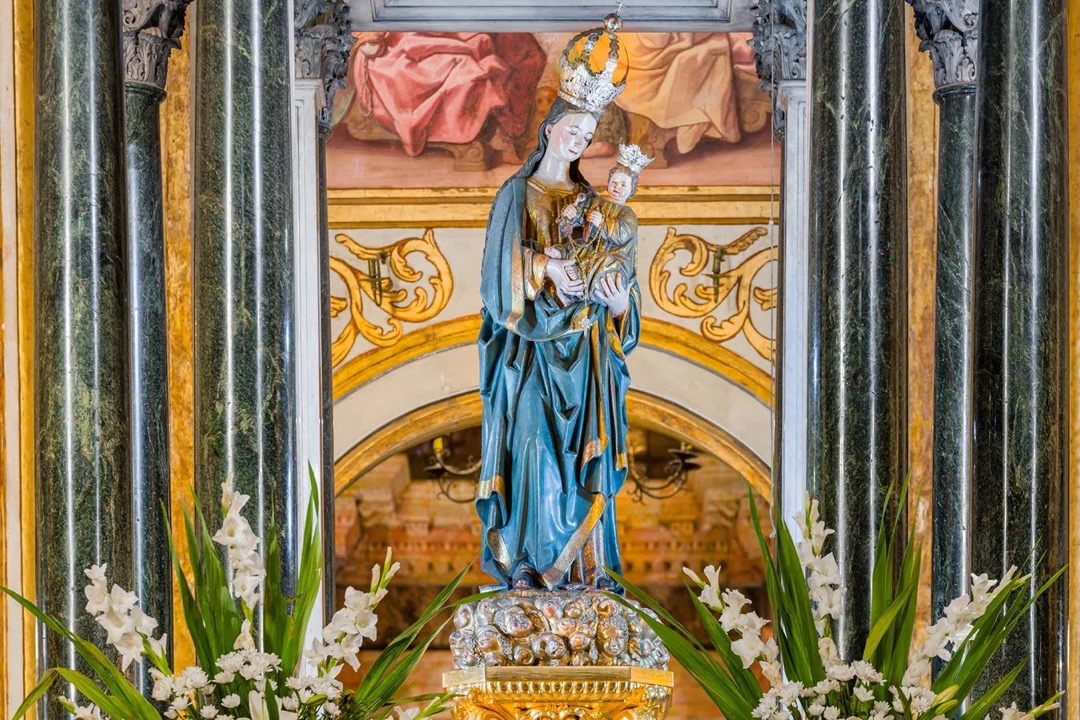
Presiding over the altar is La Virgen de la Victoria con el Niño, a 15th century German-style work that was originally in the private chapel of Ferdinand II (1452-1516).
Chapel of the Virgin of Monarchs (Capilla de la Virgen de los Reyes)
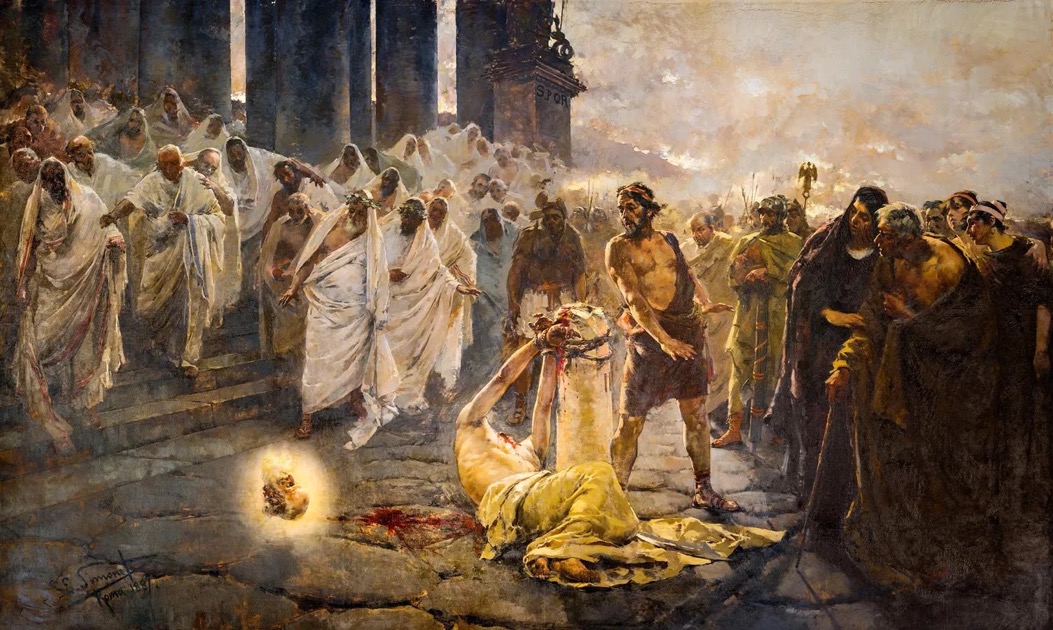
The Capilla de la Virgen de los Reyes is dedicated to a small Gothic sculpture, the “Virgen de los Reyes”, said to have been donated to the Cathedral by the Catholic Monarchs after the conquest of the city (1487). However, the highlight of the chapel is the large canvas presenting the “Beheading of St Paul”. It is the work of the Spanish artist Enrique Simonet y Lombardo (1866-1927), probably painted during his stay in Rome (1887).
The story is that Saint Paul was condemned to death by Nero sometime between 64-68 AD. He was executed at Aquae Salviae on the Via Laurentina. The legend says that his severed head rebounded three times, each time giving rise to a source of water, thus the place became known as "San Paolo alle Tre Fontane".
Chapel of the Incarnation (Capilla de la Encarnación)
The Capilla de la Encarnación is the central chapel of the Cathedral, dedicated to la Virgen de la Encarnación. Initially the space was reserved by bishop Fray Bernardo Manrique de Lara (ca. 1500-1564) for his burial, and later bishop José Molina Lario y Navarro (1722-1783) also installed his mausoleum. In the centre of the marble altar we have the sculpture of the Annunciation, and on each side the patron saints of the city, San Ciriaco and Santa Paula. No one is absolute sure about the architects and artists, i.e. the suggestion is that Ventura Rodríguez (1717-1785) was the designer, Antonio Ramos Medina (1703-1782) and José Martín de Aldehuela (1729-1802) the builders, and (I think) Juan de Aranda Salazar (ca. 1590-1654) might have been responsible for the sculptures in white marble.
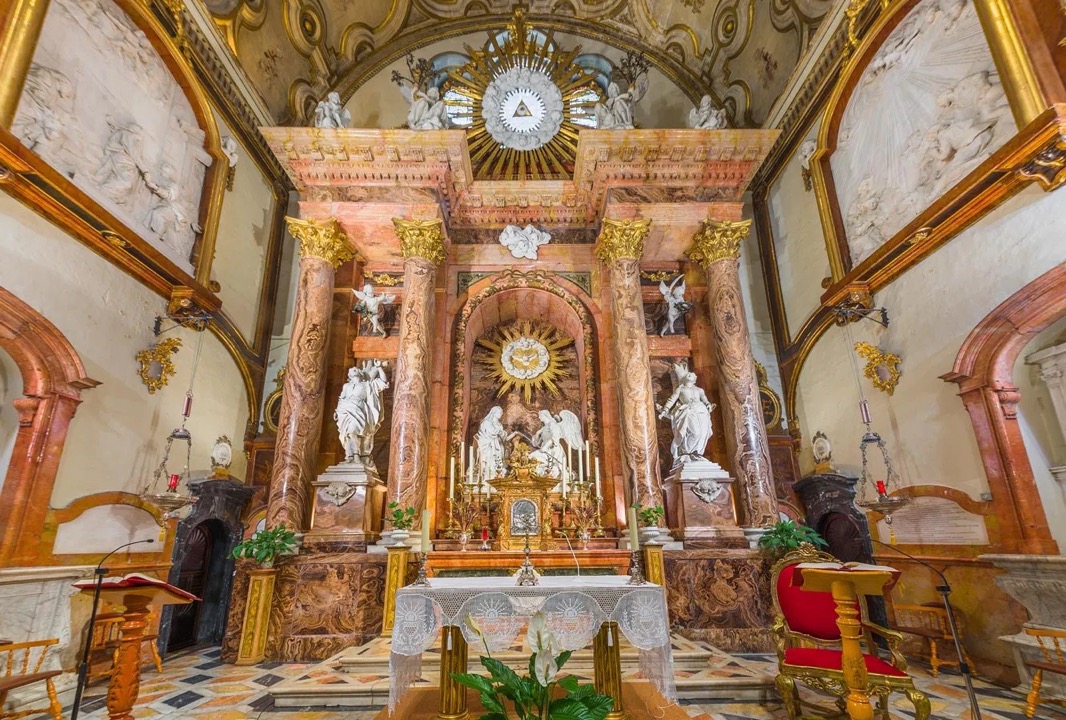
I was intrigued by some of the symbolism in this capilla. For example there is a triangle sitting on the top. Representing the number three, the triangle represents the Trinity, i.e. Father, Son and Holy Ghost. Pointing upwards it symbolises stability, rooted in the earth and water (others say its represents fire, others male energy, and others the ascension to the spiritual world). Although not totally clear in the photograph I think that there is an eye in the centre of the triangle. The “all seeing eye” is usually presented inside an upright triangle of the Trinity, and almost always with rays emanating from it (rays symbolise “infinite holiness”). The eye symbolises the omnipresence and omniscience of God. Ancient times associated the eye with the Evil Eye, and no medieval examples of the Eye of God have been found. Even during the Renaissance period they were very rare, appearing only in the 18th C.
Just above the Annunciation we can see a dove, symbolising the Holy Spirit and peace, e.g. from the dove that brought an olive branch to Noah to signify the end of the flood.
Symbols are important, as is their absence. Here we do not see symbols such as the anchor (hope), butterfly (resurrection), tree (eternal life), circle (eternity), crown of thorns (contrast to earthly authority), gate (entrance to Heaven), keys (St. Peter), or palm (victory).
Chapel of the Christ of Amparo (Capilla Cristo del Amparo)
This chapel is presided over by a crucifix, one of the most important symbols for many Christians. This one was sculpted by the Granada-born Antonio Gómez, and dates from 1600-1603. Traditionally a handful of Andalusian Baroque sculptors from Seville and Granada have been recognised as having created the great iconographic patterns for devotional objects. But the truth is that there was a legion of prolific professionals active outside these two cities. Many of these nomadic sculptors worked in Córdoba, Jaén or Málaga, and were equally creative. However, they were less easily studied because their works were often chronologically and geographically fragmented. Having learned their trade with famous teachers, they travelled with their workshops, complied with the tastes of their regional clients, and gradually fell outside the recognised schools of the time.
The world of sculpture in the early part of the 17th century in Málaga was linked to Granada's aesthetics thanks to the bothers Juan and Antonio Gómez. They were pupils of Pablo de Rojas (1549-1611), and they spread that style throughout the region of Málaga and Antequera, and in particular they monopolised the entire Málaga market for a notable period of time (Antonio was active in the period 1601-1624 before returning to Granada). There was a reason for their focus on Málaga, records show they were the son's of a Juan René who was the first printer from Granada to settle in Málaga in 1599. It is unfortunate that many of the works of the brothers were confiscated and later disappeared during the period 1931-1936.
This crucifix testifies to the importance of Pablo de Rojas in creating a new iconography that balanced the human and dogmatic needs for an image of Christ (imposed in the light of the Counter-Reformation). Typically the head and torso turn to the right, whilst the legs turn to the left. The shroud is collected in a kind of bow and the folds are a bit abrupt and have a geometric appearance. The trend was to give Christ a more athletic and robust appearance, with a certain expressiveness. Antonio was known to employ more angular planes and more powerful volumes, yielding a certain hardness to the face, etc. The wounds were restrained, there were purple tones on the eyelids, the hair was dark brown as was the eyebrows and beard, and the shroud would have a touch of gold.
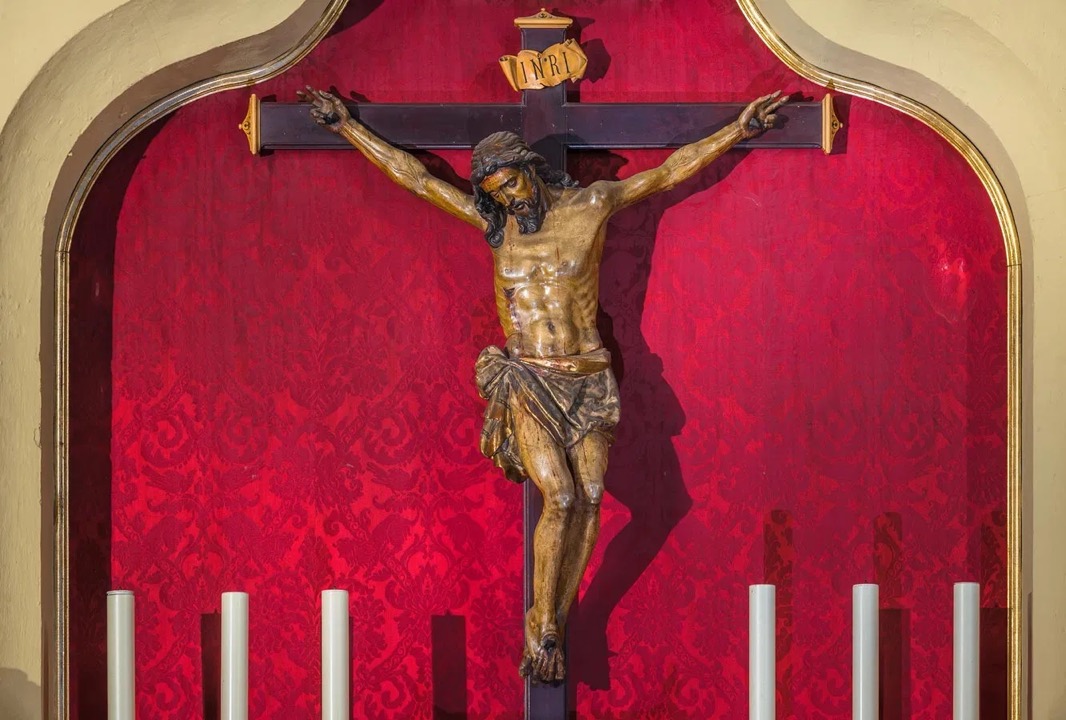
It is fitting that a webpage on a great Andalusian Cathedral closes with a crucifix.